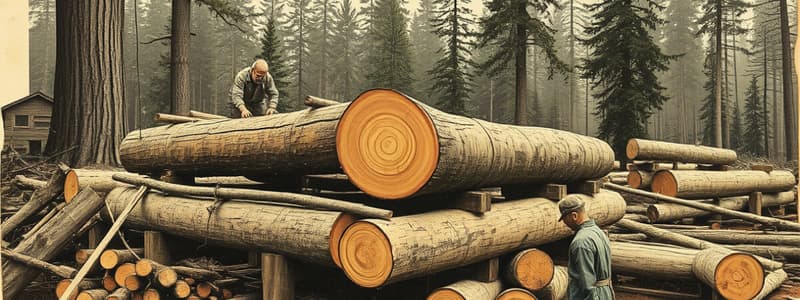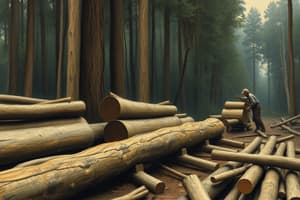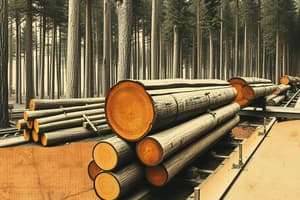Podcast
Questions and Answers
Trees and leaves provide nutrients for the soil in the ______.
Trees and leaves provide nutrients for the soil in the ______.
rainforests
Cutting down trees results in the loss of the ______ source.
Cutting down trees results in the loss of the ______ source.
seed
Trees help prevent soil ______ by holding it firmly with their roots.
Trees help prevent soil ______ by holding it firmly with their roots.
erosion
When trees are cut, ______ is released into the atmosphere, contributing to global warming.
When trees are cut, ______ is released into the atmosphere, contributing to global warming.
Without trees, communities may experience ______ and mudslides.
Without trees, communities may experience ______ and mudslides.
The cutting of trees to manufacture wood is called ______.
The cutting of trees to manufacture wood is called ______.
Lumbering has four phases: logging, driving, ______, and transport.
Lumbering has four phases: logging, driving, ______, and transport.
During certain months, logging is limited to winter when the ground is covered in ______.
During certain months, logging is limited to winter when the ground is covered in ______.
In Canada, about 40 percent of the land is covered with ______ forests.
In Canada, about 40 percent of the land is covered with ______ forests.
Canada is the leading exporter of wood products, producing about one-third of all ______ in the world.
Canada is the leading exporter of wood products, producing about one-third of all ______ in the world.
The most important trees in Canadian forests are pine and ______.
The most important trees in Canadian forests are pine and ______.
Logs are often piled above frozen rivers, waiting to be transported when the ice ______ in spring.
Logs are often piled above frozen rivers, waiting to be transported when the ice ______ in spring.
The wood of pine and fir trees is soft and easy to ______.
The wood of pine and fir trees is soft and easy to ______.
The lumbering industry ranks as the second largest industry in ______.
The lumbering industry ranks as the second largest industry in ______.
Wood has been the main product of Canadian trade since the ______ century.
Wood has been the main product of Canadian trade since the ______ century.
The timber trade brought economic development and transformed the regional ______.
The timber trade brought economic development and transformed the regional ______.
Softwood trees include ______, firs, hemlocks, spruces, and redwoods.
Softwood trees include ______, firs, hemlocks, spruces, and redwoods.
The predominant hardwood species include birch, maple, and ______.
The predominant hardwood species include birch, maple, and ______.
British Columbia produces roughly two-thirds of the ______ lumber supply.
British Columbia produces roughly two-thirds of the ______ lumber supply.
The products created by the lumber industry include plywood, particle board, and ______.
The products created by the lumber industry include plywood, particle board, and ______.
The first stage of processing trees into lumber is ______.
The first stage of processing trees into lumber is ______.
During the debarking process, ______ jets are used to remove the bark.
During the debarking process, ______ jets are used to remove the bark.
Cutting and edging involves measuring wood defects using ______ sensors.
Cutting and edging involves measuring wood defects using ______ sensors.
Lumberjacks are woodcutters who work in the ______ trade.
Lumberjacks are woodcutters who work in the ______ trade.
Loss of biodiversity occurs when trees are cut down, affecting species' ______, food, and shelter.
Loss of biodiversity occurs when trees are cut down, affecting species' ______, food, and shelter.
In the past, half of Canadian males worked as ______.
In the past, half of Canadian males worked as ______.
The lumbering industry is facilitated by cheap ______ for the operation of saw-mills.
The lumbering industry is facilitated by cheap ______ for the operation of saw-mills.
The introduction of modern machinery allowed ______ to work as loggers.
The introduction of modern machinery allowed ______ to work as loggers.
Study Notes
Lumbering Overview
- Lumbering refers to tree cutting for wood production in domestic, industrial, or commercial sectors.
- The four phases of lumbering are logging, driving, manufacturing, and transport.
- Logging is typically limited to winter months when snow and ice facilitate transportation.
Logging Process
- Logs are dragged by horses or oxen over snow-covered terrains to collection points.
- Driving is the movement of logs from collection points to sawmills, utilizing railroads when necessary.
- Manufacturing cuts logs into lumber products such as planks and boards, primarily for construction and paper.
- Transport includes finding buyers and delivery to markets, with local mills selling to nearby residents.
Lumbering in Canada
- Canada, rich in coniferous forests, covers about 40% of its land area with these resources.
- Major forests extend from Newfoundland to British Columbia, facilitating extensive lumber production.
- Canada is the world's leading wood products exporter, contributing to one-third of global lumber and timber markets.
- Lumbering is a significant winter activity; logs are temporarily stored on frozen rivers for spring transport.
Tree Species
- Lumber is produced from hardwood (e.g., oak, maple, birch) and softwood (e.g., pine, fir, spruce) trees.
- Canadian forestry is dominated by softwood species, specifically spruce, pine, and hemlock, primarily harvested in British Columbia.
- Hardwood lumber production is concentrated in Ontario and Quebec.
Lumbering Products
- Key products include lumber, veneer, plywood, particle board, wood pellets, and engineered wood.
- Manufacturing processes involve mechanical methods such as sawing and peeling.
Manufacturing Process
- Inspection involves cleaning logs and checking for defects before processing.
- Debarking uses high-powered jets or cutting blades to remove bark, often repurposed for decoration.
- Logs are cut into sizes (bucking logs) for various uses, with water sprayed to avoid drying.
- Cutting and edging involve optical sensors and computer mapping for optimal cuts, with manual oversight.
- Planing and grading prepare the wood, ensuring quality before packaging and shipment.
Factors Favoring Lumbering
- Limited species of coniferous trees are well-suited for winter logging.
- Frozen ground facilitates easier transport of logs to rivers for floating to sawmills.
- Access to hydroelectricity enhances sawmill operation in mountainous regions, supporting efficient lumbering.
Life of a Lumberjack
- Lumberjacks epitomize strength and masculinity in Canada, crucial to the timber industry since its rise.
- In the 19th century, half of Canadian males were lumberjacks; modern machinery now allows female participation.
Environmental Effects of Lumbering
- Biodiversity Loss: Habitat destruction threatens species survival and ecosystems reliant on primary trees.
- Erosion: The loss of trees leads to soil degradation and nutrient loss, making environments barren.
- Flooding: Deforestation compromises soil stability, increasing risks of floods and mudslides, endangering lives and properties.
- River Obstruction: Soil erosion leads to sedimentation in rivers, disrupting aquatic habitats critical for species like salmon.
- Climate Change: Deforestation releases stored carbon, increasing greenhouse gas concentrations and contributing to global warming's adverse effects, including extreme weather events.
Studying That Suits You
Use AI to generate personalized quizzes and flashcards to suit your learning preferences.
Description
Explore the essential phases of lumbering, which plays a crucial role in wood production for various sectors. Learn about the logging process, including techniques used, and the significance of lumbering in Canada’s vast forests. This quiz uncovers the journey from tree cutting to market delivery.




